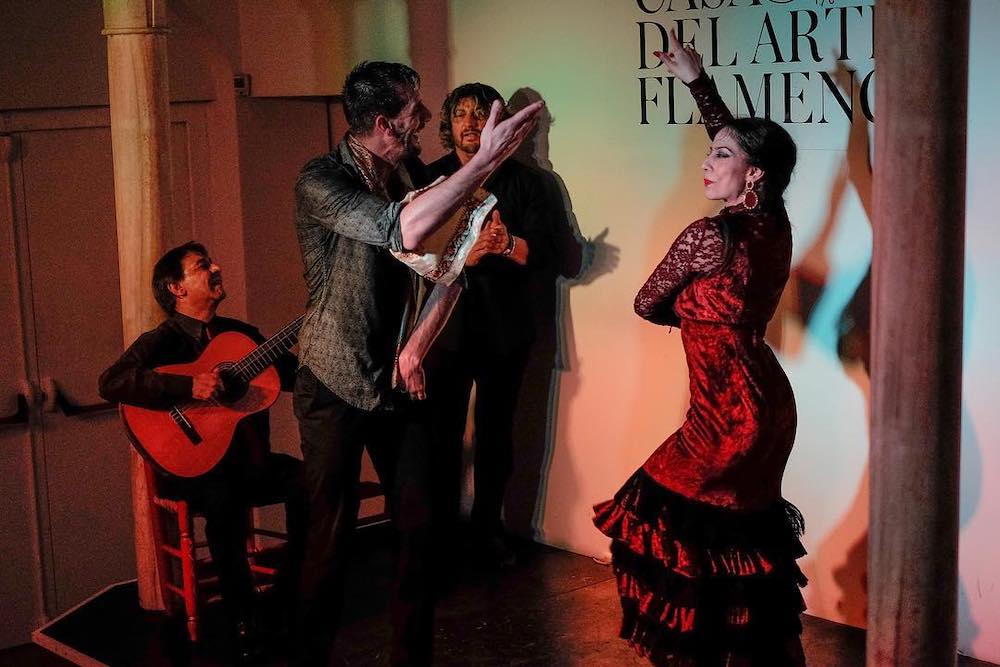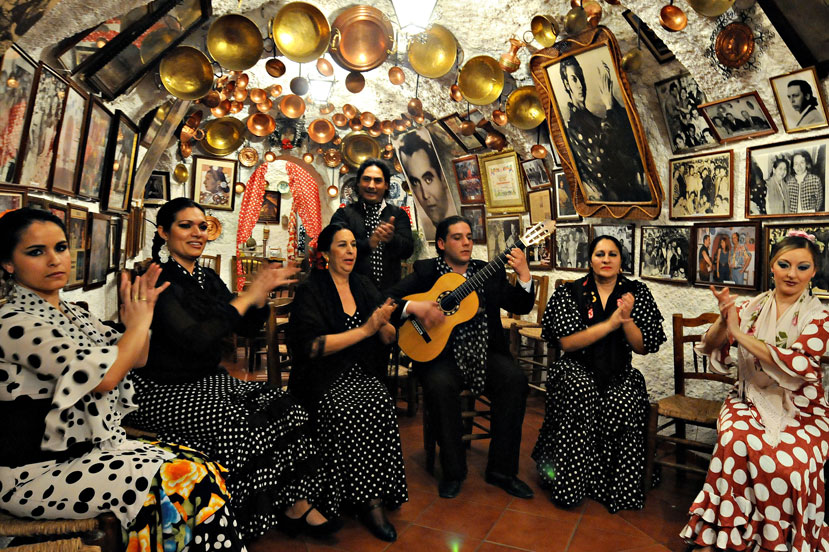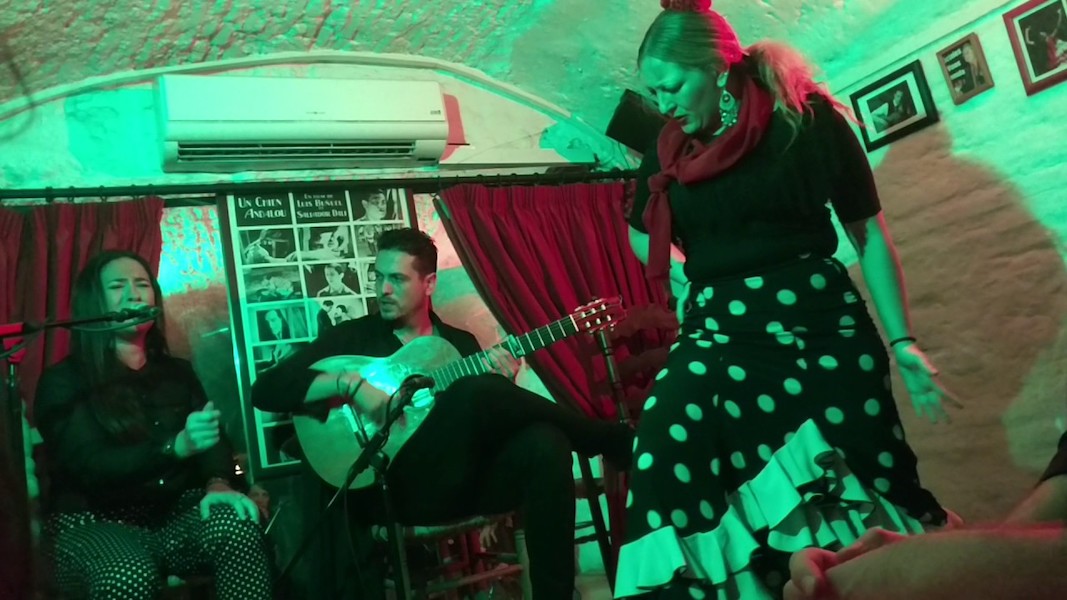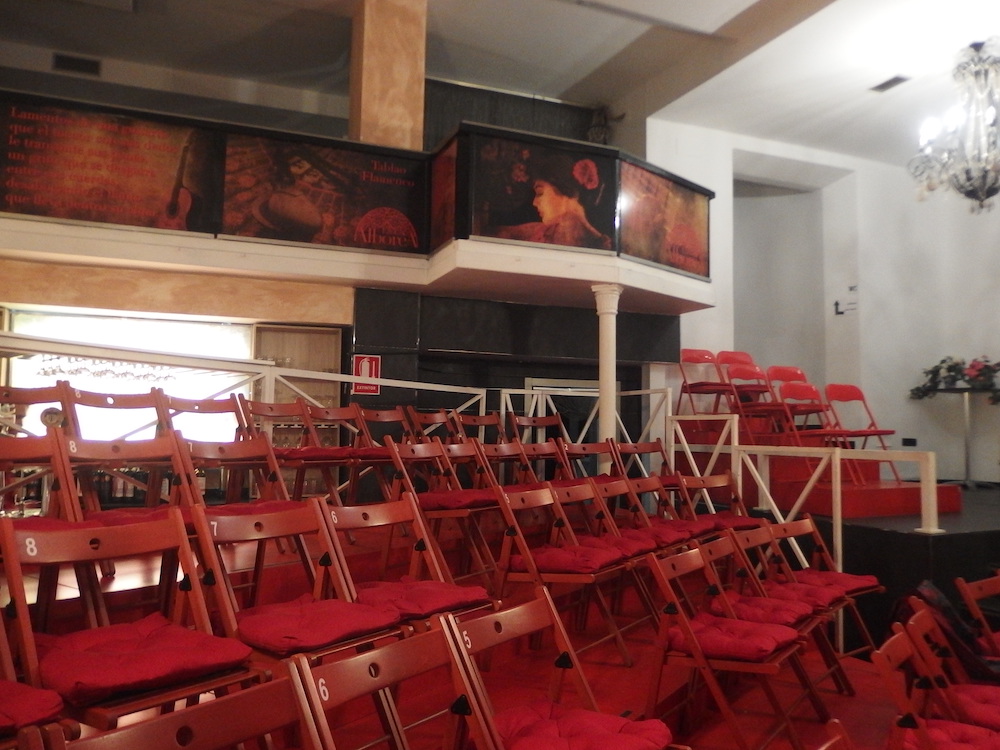
What is Flamenco?
Flamenco is a genuine Spanish art, specifically a genuine southern Spanish art from the Andalucían region. It exists in three forms: Cante, the song; Baile, the dance; and Guitarra, guitar playing.
Gypsies are very often named as the fathers of flamenco. Whilst this may be contested no one can dismiss the important part they played in its creation. Equally, the popular songs and dances of Andalucía influenced considerably early flamenco.
In a country that has been dominated by the most diverse cultures and civilisations during its different historical epochs it is no surprise there were other influences. There were the legendary Tartessos, and seven centuries of Muslim occupation that hardly could have passed without leaving traces. All that, directly or indirectly, influenced flamenco.
Flamenco History
Flamenco’s origins are a subject of much debate because it has only been documented for the past two hundred years. The word flamenco, which applies to the song, the dance and the guitar, did not come into use until the 18th century. Much of what we know before this time comes from stories that have been passed down through families, in a similar way to the flamenco song itself.
Although many of the details of the development of flamenco are lost in history, it is certain that it originated in Andalucía. From the VIII to the XV centuries, when Spain was under Arab domination, their music and musical instruments were modified and adapted by Christians and Jews, and later by gypsies becoming a hybrid music separate from the musical forms which created it.
Between 1765 and 1860, the first flamenco-schools were created in Cadiz, Jerez de la Frontera and Triana (Seville). In this epoch flamenco dance started to have its firm position in the ballrooms. Early flamenco seems to have been purely vocal, accompanied only by rhythmical clapping of hands, toque de palmas. It was left to dedicated composers such as Julián Arcas, to introduce guitar playing.
During its Golden Age (1869-1910) flamenco was developed in the numerous music cafés known as cafés cantantes. Also the more serious forms expressing deep feelings (cante jondo) date from then. Flamenco dance reached its climax during this time, being the major attraction for the public of those cafés cantantes. Guitar players featuring the dancers increasingly gained a reputation.
The time from 1910 to 1955 flamenco singing is marked by the ópera flamenca, with an easier kind of music such as fandangos and cantes de ida y vuelta. The latter clearly showed South American influences.
From 1915 on flamenco shows were organised and performed all over the world. Not everybody was enchanted with that development and intellectuals such as Falla organised in Granada 1922 a contest to promote “pure” cante jondo.
1955 started a sort of Flamenco Renaissance, with the great performer Antonio Mairena being its key figure. Outstanding dancers and soloists soon made their way out of the small tablaos, successors to the early cafés cantantes, to the great theatres and concert houses. It was now that guitar players acquired a great protagonism, and their playing reaching maturity. The flamenco guitar which formerly was just featuring the dancers arrived to be a soloist art form. Great virtuosos like Paco de Lucia played an essential roll in this development.
Mass media have brought flamenco to the world stage, but deeply it has always been and will remain an intimate kind of music. That’s why one of the most authentic flamenco you may experience is in a juerga (flamenco party) with a small group of friends, at midnight somewhere in the South of Spain, when there is nothing around but the voice, the guitar and the body of a dancer moving in the moonlight.
On 16 November 2010 flamenco was designated World Intangible Cultural Heritage by UNESCO. This strengthens and asserts the importance of this hallmark of Andalucían artistic expression. The year following its declaration as World Heritage, as an anniversary celebration for this event, the Andalucían Regional Government declared this date “Flamenco Day in Andalucía”.


To understand the roots of flamenco in Granada we have to take a look back in time to the heart of Grenadian flamenco, Sacromonte.
The name of Sacromonte, which translation is sacred mountain, has an uncertain origin, some historians consider it named by the Christians in the 14th century, due to the presence of an Islamic Graveyard there.
The main characteristic of Sacromonte is the troglodyte settlement. Their inhabitants have been digging their homes in the mountain for centuries, generating a traditional Granadian house known as caves. On the outside they resemble any other house, beside the fact that their facade is sustained on the rock. The inside is caved and has a very particular shape that make them unique in the world.
The Sacromonte is one of the known origins of flamenco in Spain. After the conquest of Granada in 1492 Moorish people were pushed out of the city walls and settled in the Sacromonte, there they met the gypsies. Since that moment both cultures coexisted and merged in several ways. There was a strong affinity between them due to both being considered outcast by society. In 1499 a law signed by the Catholic Kings forced the gypsies to abandon their nomad way of life. Thus, after the ban of the Moors, Sacromonte became a permanent quarter for gypsies in Granada.
Zambra incorporates two distinct Andalucían music genres: The first belongs to the ritual of the gypsies of Granada and the second, a theatrical style created by Manolo Caracol which aimed to recreate the Moorish atmosphere of the caves of Sacromonte, thus exploiting the exotic atmosphere of the fifties.
To understand the origin of the Zambra, the traditional Granadian flamenco, one first has to appreciate the role of the Moors and gypsies. Its name, Zambra, comes from the Arabic zumrã, “party”. It was the wedding ritual and party that Granadian Moors used to celebrate. It became prohibited by the inquisition in the 16th century but continued to be celebrated in secret. This tradition was absorbed, learned, and transformed by the Sacromonte’s gypsies, who embraced the Zambra as their own. Gypsies retain the remnants of the whole Moorish musical tradition. They are the ones that nurture the Moorish traditions and they have turned them into flamenco as we know it today.
It was in the 18th and 19th centuries, when romantic writers arrived in Granada, when the Zambra and flamenco burst through as an art expression appreciated worldwide. It was precisely this appreciation that made flamenco a formal discipline and a musical style.
It was at this time that romantic writers arrived in Granada, when the flamenco caves of the Sacromonte became famous. Travellers went to Sacromonte to meet the raw and pure Spanish gypsy culture. This is the reason why romantic travellers pictured Andalucían people permanently dressed in flamenco suits. Why? Because gypsies were standing outside the caves always ready to perform their flamenco show for the travellers. The first gypsy family meeting the visitors was the one that had the right to perform and charge for the spectacle. That’s the reason they were always dressed in flamenco suits and the reason why that cliche still remains.
Where to see flamenco in Granada?
Venues vary from the traditional caves to bars, restaurants and theatres. Some venues offer meals or tapas to enjoy before or during the show. A selection of venues are described below.
Jardines de Zoraya

 Jardines de Zoraya offers a pleasant experience for the palate and for the senses. Have dinner with them or savour a good glass of wine while the best artists of the current scene make you discover the duende and the passion of flamenco art.
Jardines de Zoraya offers a pleasant experience for the palate and for the senses. Have dinner with them or savour a good glass of wine while the best artists of the current scene make you discover the duende and the passion of flamenco art.
One hour of intense flamenco in the heart of the Albaicín, the most emblematic place in Granada. Gastronomy and art meet in their tablao. Reserve your table for dinner or to attend the show. They offer you two daily shows at 8:00 p.m. and 10:30 p.m. Because wherever you come from, they want you to feel at home.
The price for the 1 hour show is €20 (2020). Food and drink are extra. You can book online at their website (see below).
Address: Calle Panaderos 32, 18010, Granada.
Telephone: +34 958 206 266
Open: 12 – 23:30
For further information please look here.
El Templo del Flamenco

 The Cave of ‘El Templo del Flamenco’ is an imposing Grenadian cave divided into three main caves, creating the shape of a cross, which are unified in a central area where the ‘tablao’ is located, raised one meter above the ground, to favour visibility from any point in the caves.
The Cave of ‘El Templo del Flamenco’ is an imposing Grenadian cave divided into three main caves, creating the shape of a cross, which are unified in a central area where the ‘tablao’ is located, raised one meter above the ground, to favour visibility from any point in the caves.
Thanks to its latest renovation, the flamenco cave ‘Templo del Flamenco’ is considered to be one of the best in Granada. Therefore, their show and their typical Andalucían restaurant, is the best combination to enjoy the art of flamenco in Granada.
Great flamenco dancers that overflow with art , showing the essence of flamenco in each of their performances, giving it all on the ‘tablao’, 60 minutes filled with the magic of flamenco.
They offer several packages featuring different menus including for children and vegans. Or, you can just enjoy the show with a drink. You can book online at their website (see below).
Address: Calle Pernaleros Alto, 41, 18010 Granada
Telephone: +34 622 500 052
Open: Arrival time 9:30pm with or without meal, starting the show at 10pm.
For further information please look here.
La Casa del Arte Flamenco

 Impressive but considerably more formal, La Casa del Arte is a cultural space designed to showcase the art of flamenco in Granada in its truest form. Instead of a cave home or a casual patio, this place has a 40-seat theatre with a small stage. Here, you get top-notch, beautiful performances by some of Spain’s best professional dancers.
Impressive but considerably more formal, La Casa del Arte is a cultural space designed to showcase the art of flamenco in Granada in its truest form. Instead of a cave home or a casual patio, this place has a 40-seat theatre with a small stage. Here, you get top-notch, beautiful performances by some of Spain’s best professional dancers.
The show lasts approximately 60 minutes, enough time to explore different flamenco styles, our artists through song, music and dancing will make you feel the passion of flamenco.
There is also a restaurant so you can combine the show with a meal.
Address: Calle Cuesta Gomerez 11, 18009 Granada
Telephone: +34 958 565 767
Open: Arrival time 9:30pm with or without meal, starting the show at 10pm.
For further information please look here.
Zambra María la Canastera

 Located in the picturesque quarter of Sacramonte, this venue is a traditional cave home with whitewashed walls. Decorated with photographs of their famous visitors as well as traditional Sacromonte craftwork (pottery and hammered copper) the venue has a capacity for 60 people. Shows are scheduled every night with singing and dancing masterfully performed by María’s descendants, who keep the traditions left by her alive today.
Located in the picturesque quarter of Sacramonte, this venue is a traditional cave home with whitewashed walls. Decorated with photographs of their famous visitors as well as traditional Sacromonte craftwork (pottery and hammered copper) the venue has a capacity for 60 people. Shows are scheduled every night with singing and dancing masterfully performed by María’s descendants, who keep the traditions left by her alive today.
María Canastera’s cave, for its good work, is considered the most emblematic of Sacromonte, being the only one of many that continues to offer the songs and dances of gypsy weddings known as the Zambra.
Enrique el Canastero, Maria’s son now owns and takes care of the cave with the same affection and spirit as his mother. He has preserved the cave in its original condition which is why it is considered by cultural institutions as one of the museums of Granada. Maria’s cave has a privileged position among Granada’s tourist high spots, given that it is the best conserved and most emblematic of flamenco houses, deserving its fame throughout Spain and abroad.
You can book online at their website (see below).
Address: Camino del Sacromonte, 89, 18010 Granada
Telephone: +34 958 121 183
For further information please look here.
Venta El Gallo

 La Venta El Gallo, with its privileged location in front of the Alhambra in Granada, offers Andalucían cuisine and quality flamenco shows.
La Venta El Gallo, with its privileged location in front of the Alhambra in Granada, offers Andalucían cuisine and quality flamenco shows.
As another Sacromonte cave venue, it offers the opportunity for close proximity with the artists. La Venta El Gallo is the house of flamenco art of Sacromonte where they always strive to get away from the concept of the flamenco show for tourists and focus on the purity of the art above all else. That is why in the flamenco tablao of their cave is “really” music, song, and dance, always live and by the best artists of Granada. Feel the strength and passion of their artists and start enjoying the soul of flamenco.
In Venta El Gallo they have two environments. If you wish, you can dine inside our dance cave, in an atmosphere full of traditional flavour with whitewashed walls and copper tools. It is a unique space in which gastronomy and flamenco go hand in hand. Alternatively, you can dine in their restaurant.
Few restaurants in Granada can boast such exclusive and privileged views of the Alhambra as theirs. The restaurant is located in the hills of Valparaiso, in an authentic Sacromonte cave from which you can see the wide Darro valley. And in front of the restaurant are the high towers of the Alhambra, the silhouettes of its palaces and the peaks of the Sierra Nevada.
Address: Barranco de los Negros 5, Sacromonte, 18010, Granada
Telephone: +34 958 22 84 76
For further information please look here.
Le Chien Andalou

 In Le Chien Andalou (“The Andalucían Dog”) you can enjoy a flamenco show combining the flamenco tradition of Granada and its evolution giving rise to a flamenco show full of sensitive emotion that will delight you. All this is combined in a historical environment, the cistern where we are located. You will be immersed in an old water tank from the Arab era, known as a cistern, which served to supply the city with water in the Nasrid era, and today transformed and conditioned into a flamenco tablao to immerse the spectator in the soul of flamenco.
In Le Chien Andalou (“The Andalucían Dog”) you can enjoy a flamenco show combining the flamenco tradition of Granada and its evolution giving rise to a flamenco show full of sensitive emotion that will delight you. All this is combined in a historical environment, the cistern where we are located. You will be immersed in an old water tank from the Arab era, known as a cistern, which served to supply the city with water in the Nasrid era, and today transformed and conditioned into a flamenco tablao to immerse the spectator in the soul of flamenco.
Every day a different set of flamenco artists from the city perform providing the opportunity to enjoy the three most common forms of flamenco; singing, dancing and flamenco guitar.
They are typically sold out as it is an intimate and exclusive space, so they recommend buying your tickets in advance.
They have three daily performances: (Note: it is necessary to arrive 1 hour before the start of the show.)
- Summer; 20:00, 22:00 & 00:00.
- Winter; 19:30, 21:30 & 23:30.
You can accompany the show with drink and food. The flamenco dinner has different menus for people with different tastes or different nutritional practices such as vegetarians or vegans. It can be enjoyed during the flamenco show.
You can book online at their website (see below).
Address: Carrera del Darro, 7, 18010, Granada
Telephone: +34 617 106 623
For further information please look here.
Cuevas los Tarantos

 The caves “Los Tarantos” were founded in 1972. José Martín Quesada and Concepción Maya Maya bought a cave in Granada’s Sacromonte district, which become the Zambra Flamenco “Cuevas Los Tarantos”. Thanks to the artists and to their father and founder Don José Martín, Maya Conceptión and children they claim to have the honour of leading the most traditional flamenco in Granada.
The caves “Los Tarantos” were founded in 1972. José Martín Quesada and Concepción Maya Maya bought a cave in Granada’s Sacromonte district, which become the Zambra Flamenco “Cuevas Los Tarantos”. Thanks to the artists and to their father and founder Don José Martín, Maya Conceptión and children they claim to have the honour of leading the most traditional flamenco in Granada.
In the neighbourhood of Sacromonte, the most emblematic place of flamenco in Granada, you will find the Caves of Los Tarantos. Every night in their cave they present a large cast of artists, many of them prominent figures from Granada Flamenco, which delight at every show with their skill in dance, singing and guitar playing.
They offer a range of options, you can opt for the show and drink, show and dinner with or without transport. The first show starts at 21:30 and the second show at 22:30.
In the Caves Los Tarantos you can enjoy the most delicious Andalucían cuisine in a cosy atmosphere. They offer a range of dishes with the flavours and colours of traditional Grenadine cuisine. Share a unique experience with an extraordinary show accompanying a delicious dinner in our caves surrounded by the purest flamenco.
Address: Plaza de Toqueros 7, Albayzín, Granada
Telephone: +34 958 22 45 25
You can book online at their website (see below).
For further information please look here.
Peña la Platería

 Top of the list with a combination of talent and ambience is Peña la Platería. Located in Granada’s Albaicín district, this is a world-famous and widely respected flamenco club. It first opened its doors in 1949 and is one of the oldest clubs in Spain. For decades the country’s most renowned dancers singers and musicians have played there, attracting visitors from all over the world.
Top of the list with a combination of talent and ambience is Peña la Platería. Located in Granada’s Albaicín district, this is a world-famous and widely respected flamenco club. It first opened its doors in 1949 and is one of the oldest clubs in Spain. For decades the country’s most renowned dancers singers and musicians have played there, attracting visitors from all over the world.
These days they only offer shows once a week, so make sure to plan ahead if you want to catch one. If you’re in town for longer, you can even sign up for weekly classes to learn the basics of flamenco guitar and singing. A bonus is the Peña’s privileged location in the Albaicín offering stunning views of the Alhambra.
Address: Plaza de Toqueros 7, Albayzín, Granada
Telephone: +34 958 21 06 50
When: Thursday evenings at 22.00
For further information please look here.
El Tabanco

 El Tabanco proves that it’s possible to see truly authentic flamenco in Granada without settling for the expensive package deals that many of the bigger venues offer. However, if you’re looking for the vibrant spectacle of a full-on dance performance, you won’t find it here. Instead, you’ll be treated to the other side of flamenco culture: the music itself. Several nights a week, talented singers and musicians gather here to play for a small crowd of appreciative locals and tourists alike.
El Tabanco proves that it’s possible to see truly authentic flamenco in Granada without settling for the expensive package deals that many of the bigger venues offer. However, if you’re looking for the vibrant spectacle of a full-on dance performance, you won’t find it here. Instead, you’ll be treated to the other side of flamenco culture: the music itself. Several nights a week, talented singers and musicians gather here to play for a small crowd of appreciative locals and tourists alike.
The Tabanco hosts exhibitions of painting, photography and sculpture. During the day guitar and singing lessons are taught. It has a recording studio where they collaborate with musicians in both live and professional recordings. It is a meeting place for flamingos and music lovers from anywhere in the world.
The entry fee is just €6, and once inside you can enjoy various tapas and regional wines. The little patio only has space for a dozen or so guests, making the whole experience extra intimate. In case you want to switch it up, El Tabanco also offers jazz nights on Tuesdays.
Address: Cuesta de San Gregorio, 24, Albaicín, Granada
Telephone: 662 137 046
For further information please look here.
Palacio de Los Olvidados

 The Palacio de Los Olvidados Flamenco is located inside the Palace of the Forgotten, at the foot of the Alhambra and next to the Carrera del Darro, one of the most charming and bewitching places in Granada. This 16th-century building has been renovated to offer traditional flamenco shows, making it the most recommended scenic space with the highest artistic quality in the city.
The Palacio de Los Olvidados Flamenco is located inside the Palace of the Forgotten, at the foot of the Alhambra and next to the Carrera del Darro, one of the most charming and bewitching places in Granada. This 16th-century building has been renovated to offer traditional flamenco shows, making it the most recommended scenic space with the highest artistic quality in the city.
Address: Cuesta de Santa Ines 6 Inside of Palacio de los Olvidados, 18010 Granada
Telephone: +34 958 19 71 22
For further information please look here.
La Alboreá

 Due to the acoustics of the hall, you can enjoy the most natural and authentic live flamenco. Sober and careful decoration and warm lighting create a special, colourful and intimate atmosphere.
Due to the acoustics of the hall, you can enjoy the most natural and authentic live flamenco. Sober and careful decoration and warm lighting create a special, colourful and intimate atmosphere.
The close proximity to the performers, very close to the tablao, makes you tremble from the passions and emotions exuded from the flamenco.
You have the choice of being close to the performers on the tablao in the main grandstand with comfortable, individual and numbered seats or the intimate atmosphere of their VIP area on the top floor where you can be served with a delicious dinner to complement your evening of flamenco.
Address: Calle Pan, 3 18101, Granada
Telephone: +34 664 362 540
You can book online at their website (see below).
For further information please look here.
